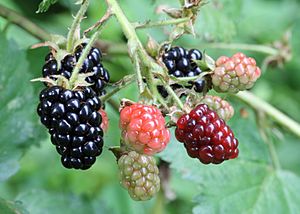Paleolithic diet facts for kids
The Paleolithic diet is a modern way of eating. It's also called the 'caveman diet' or 'Stone Age diet'. This diet tries to copy what humans might have eaten during the Paleolithic era.
The Paleolithic era was a very long time ago. It lasted about 2.5 million years. It ended around 10,000 years ago, when people started farming instead of hunting and gathering.
People on the modern Paleolithic diet eat foods like meat, fish, vegetables, fruit, roots, and nuts. They try to avoid foods that became common after farming started. These include grains, legumes, dairy products, salt, refined sugar, and processed oils. This diet usually has fewer carbohydrates and more protein than many modern diets.
Walter L. Voegtlin first made this diet popular in the 1970s. The main idea behind it is that our bodies are best suited for the foods our ancestors ate. This is because human genetics haven't changed much since people began farming. So, eating like our ancient ancestors might be healthier for us today.
Some studies have shown good health results for people following the Paleolithic diet. However, it is a bit controversial among nutritionists and anthropologists. Some experts wonder if the health benefits come from other reasons, like eating fewer calories. They also question if we truly know what people ate in the Paleolithic era.
Contents
Why Modern Diets Can Be Unhealthy
Many experts agree that today's diets in many rich countries are causing health problems. For example, Obesity (being very overweight) has become much more common. In some places, the number of overweight children has nearly doubled in recent years.
Being overweight can lead to serious health issues. These include 'adult-onset' type 2 diabetes, which used to be rare in children. This type of diabetes can cause problems like losing limbs or going blind. Some experts even worry that today's children might not live as long as their parents.
One reason for these problems is that we eat a lot more calories than we used to. But we don't do as much hard physical work. The Industrial Revolution brought machines that do much of the heavy lifting. This means we burn fewer calories than our ancestors did.
It's not just about fat and carbohydrates. We also eat much more salt today. For example, typical adults in the United States eat nearly 4,000 mg of sodium each day. About 75% of this salt is added to food during processing. Our ancestors ate much less salt.
These modern eating habits, combined with less exercise, can lead to serious diseases. These include cardiovascular disease (heart problems), high blood pressure, type 2 diabetes, osteoporosis (weak bones), and cancer.
The Idea Behind the Paleo Diet
The Paleolithic diet is based on ideas from evolutionary biology. The main thought is that our bodies and how they use food (our metabolism) got used to the foods available during the Paleolithic era. This happened over millions of years through natural selection.
However, farming only started about 10,000 years ago. This isn't enough time for our genetics to fully adapt to new foods like grains and dairy. Supporters of the Paleo diet believe this mismatch between our ancient bodies and modern food causes many diseases.
More than 70% of the energy people get in the United States comes from foods like dairy, cereals, refined sugars, and processed oils. Paleolithic diet supporters say these foods were not eaten during the Paleolithic era.
However, some evidence suggests that early humans might have used cereals for food much earlier than thought. This could have been as far back as 23,000 years ago, or even 200,000 years ago. But Loren Cordain, a key figure in the modern paleo diet, argues that grains were not a major part of the ancient diet. He also says that eating wild grass seeds would have needed special tools and processing. These tools probably weren't available over 100,000 years ago.
Why Some People Disagree
Not everyone agrees with the evolutionary reasons behind the Paleolithic diet. Some researchers, like Alexander Ströhle and his team, say that the idea of our genes being stuck in the Pleistocene (the period before 11,550 years ago) might not be fully correct.
They argue that 10,000 years might have been enough time for humans to adapt to farm-based diets. For example, genes that help people digest dairy became common in Europe just a few thousand years after people started raising animals. This shows that human genes can adapt relatively quickly to new foods.
There is also evidence that Stone Age humans might have eaten some refined starches and grains. A study from 2010 found a 30,000-year-old mortar and pestle. These tools were used to make flour from several plants. This suggests that early humans might have processed plant foods more than previously thought.
Images for kids
-
Roast beef. Some recent paleo diet variants emphasize the consumption of unprocessed animal products.
See also
 In Spanish: Dieta paleolítica para niños
In Spanish: Dieta paleolítica para niños






